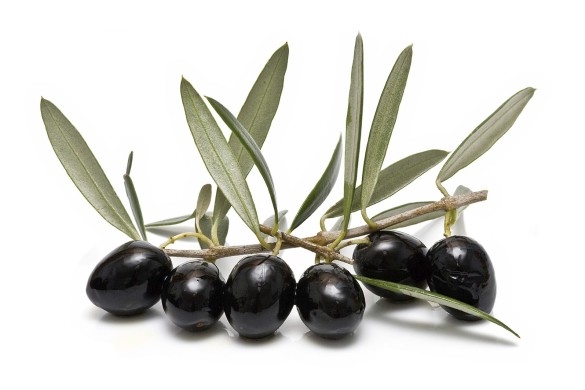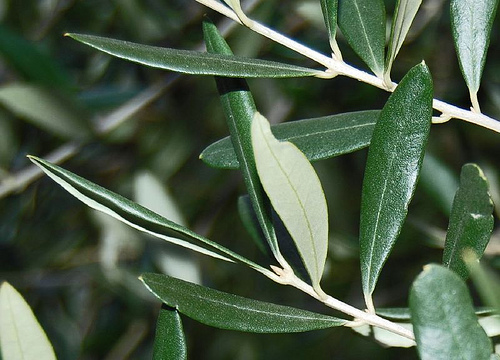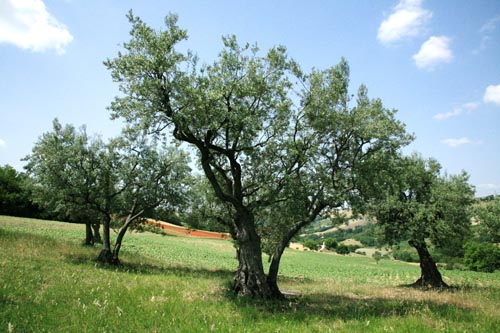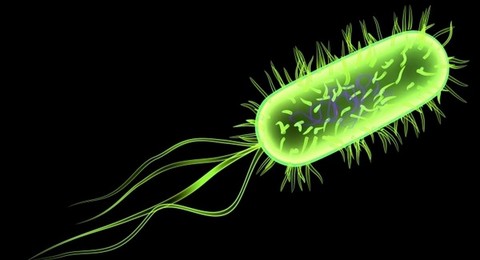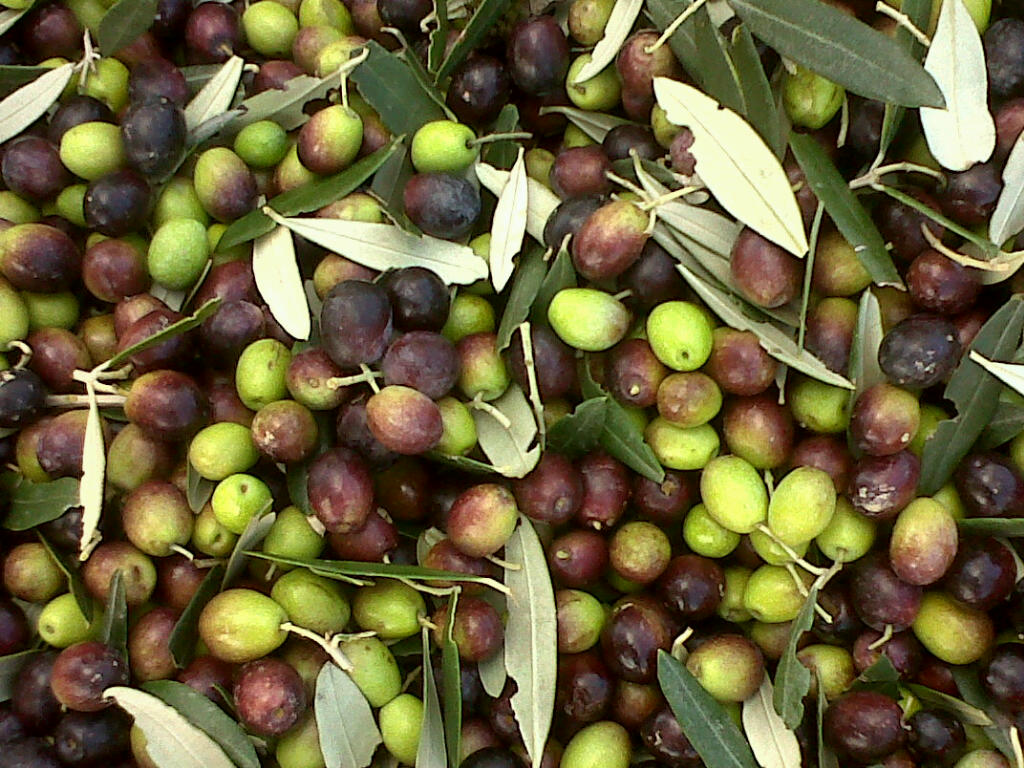 Few things in life are 100% guaranteed. This holds true for nutritional supplements, too. Yet, while olive leaf extract isn’t a panacea, it’s something everyone should consider taking when seeking to optimize health or effectively combat a virulent infection. Because when it comes to antimicrobial action, nothing beats taking the right olive leaf extract.
Few things in life are 100% guaranteed. This holds true for nutritional supplements, too. Yet, while olive leaf extract isn’t a panacea, it’s something everyone should consider taking when seeking to optimize health or effectively combat a virulent infection. Because when it comes to antimicrobial action, nothing beats taking the right olive leaf extract.
A true story. While writing this article, I unfortunately was exposed to several individuals who were not feeling well, and who were in fact fighting either colds or the flu. Shortly thereafter, I started taking six capsules of Olive Leaf Extract daily. Perhaps I should have started sooner. I suffered just one uncomfortable day and part of a night. I felt 90% better the very next day, and I pulled out of it from there. I believe I have olive leaf extract to thank for my fast recovery.
MICROBES AND THE HUMAN MICROBIOME
We live in a world filled with fascinating and dangerous pathogenic microbes. These include antibiotic-resistant bacteria, viruses (including retroviruses), yeasts and opportunistic fungi, as well as parasites (i.e., protozoa and helminthic worms). Biological science tells us more about these primitive, infectious agents every day.
Recent research reveals that when you count all the genetic material in, on, and around a human being, only about 10% of is actually human DNA. That is, the “microbiome” that surrounds us and includes our DNA is 90% made-up of microbes!
This discovery of the true nature of the human microbiome fundamentally changes how we must think of ourselves as humans. It has major implications for 1) how we interact with, and share, genetic information with the microbes in our microbiome, 2) how microbes communicate among themselves to build resistance to pharmaceuticals and develop into “superbugs,” and 3) how we can support the health of our microbiome by natural means that create balance and maintain healthy populations of “beneficial” bacteria.
A well established fact is the development of drug resistance in microbes. Many of the most potent antibiotics no longer work effectively to protect us. Moreover, pharmaceutical drugs typically kill microbes indiscriminately, the beneficial ones and the harmful ones alike.
This causes problems for health because unless the body is rapidly repopulated with beneficial microbes, the human microbiome becomes imbalanced in favor of harmful microbes that lead to adverse health conditions. The fact is that we live in a “post-antibiotic” era.
Fortunately, there are potent natural antimicrobials, immune modulators, and amazing health-building supplements. These include foods like garlic, food-based complexes (e.g., medicinal mushrooms), high potency plant-based antioxidant formulas (including Nrf2 activator formulas like Ultimate Protector™), and herbal extracts like olive leaf extract. Many of these herbs and therapeutic substances work both by direct antimicrobial activity and support our immune system to help it combat foreign pathogens.
WHY OLIVE LEAF EXTRACT?
Olive leaf extract is unique and different. In fact, olive leaf extract is of particular interest not only because its antimicrobial activity is just as potent (or more so) than other natural antimicrobials, but also because it offers significant benefits that are unique to itself.
• Olive leaf extract offers the benefits of being a broad-specrum antimicrobial while at the same time exhibiting no harmful effects on beneficial microbes. This is a key benefit because it means that it will not induce the types of side effects associated with antibiotics, and especially will not lead to secondary infections related to a preponderance of harmful bacteria.
• A related benefit is that while certain types of bacteria are resistant to most (or all) classes of antibiotics, these same bacteria remain vulnerable to olive leaf extract. This makes olive leaf extract one of the most important natural substances for battling some of the most dangerous infectious agents.
• Another major benefit is that olive leaf extract can directly stimulate phagocytosis, the process whereby white blood cells engulf and consume harmful bacteria in the body. The immune system already supports phagocytosis, but olive leaf extract can increase the activity of phagocytes, such as macrophages.
• Olive leaf extract offers many additional, specific benefits for health. I will discuss more of them below.
DISCOVERY OF A SUPERIOR OLIVE LEAF EXTRACT
An important fact is that there is one type of olive leaf extract that is most effective against pathogens. It is a form of olive leaf extract that relies upon a patented process to concentrate active ingredients that cannot be deactivated by proteins in the human bloodstream. This form is the one contained in HPDI’s Olive Leaf Extract formula.
For centuries, the active ingredients in olive leaves were unknown. During the 19th century, a phenolic compound known as oleuropein was isolated from olive leaves. It was later determined that this bitter glucoside is present throughout the olive tree, i.e., it its leaves, fruits (olives), bark, and roots.
Botanists consider oleuropein to be the substance that protects the living tree from pests and disease. It helps the olive tree survive for centuries and even for millennia (see more below).
In the late 1960s, the Upjohn company isolated the primary antimicrobial ingredient present in oleuropein. This ingredient was the calcium salt elenolic acid, known chemically as calcium elenolate. Calcium elenolate was highly effective against nearly every bacterium, virus, yeast, fungus, and protozoan against which it was tested.
The effectiveness of calcium elenolate, however, remained confined to the test tube (in vitro) because it was determined the proteins in the blood stream bound to it. This rendered calcium elenolate ineffective in the body (i.e., in vivo) after just a few minutes.
Upjohn did much beneficial research, but abandoned its attempts to find a patentable form of olive leaf extract because the company could not surmount the problem of the active ingredient being bound by serum proteins in blood.
In 1994, a company (East Park Research, Inc.) discovered a method for processing olive leaves that would concentrate an active form of the extract that would not be inactivated by proteins in the bloodstream.
East Park built upon the research done by Upjohn to develop a calcium elenolate product for practical use. That is, the company created an olive leaf extract formula that preserves all the antimicrobial effectiveness of pure calcium elenolate in vitro without any reduced effectiveness in the human body (in vivo). This discovery represents an important breakthrough that has given us access to using olive leaf extract to support human health.
HPDI offers the form of olive leaf extract developed by East Park research. While many companies have developed and sell olive leaf extract formulas, most of these are based on oleuropein or other components in olive leaf.
Standard olive leaf extracts may exert some effectiveness as antimicrobials, but their potency is limited by the fact that serum proteins inactivate the primary active ingredient (calcium elenolate). This is same problem encountered by Upjohn, and solved by East Park Research, Inc. That is why the best form to take is olive leaf extract created using the process patented by East Park.
KEY BENEFITS OF EAST PARK OLIVE LEAF EXTRACT
• EXTREMELY POTENT & EFFECTIVE ANTIMICROBIAL
• BROAD SPECTRUM – KILLS OR INCAPACITATES A WIDE VARIETY OF VIRUSES, BACTERIA, FUNGI, AND PARASITES
• EFFECTIVE AGAINST ANTIBIOTIC-RESISTANT BACTERIA
• FIGHTS COLDS AND FLU (INFLUENZA)
• HELPS CHRONIC FATIGUE SYNDROME & FIBROMYALGIA
• USEFUL FOR CANDIDIASIS, YEAST INFECTIONS & OTHER FUNGAL PROBLEMS
• EXERTS POSITIVE EFFECTS ON THE HEART
• LACKS THE SIDE EFFECTS ASSOCIATED WITH PHARMACEUTICAL ANTIBIOTICS
• SUPPORTS IMMUNITY NATURALLY AND STIMULATES PHAGOCYTOSIS
• EXERTS ANTI-GLYCEMIC EFFECTS BENEFICIAL FOR BLOOD SUGAR CONTROL
• ACTS AS AN ANTI-HYPERTENSIVE
• EXTREMELY SAFE, PLANT BASED
• CONVENIENT CAPSULE FORM
Here is a partial list of infectious diseases against which Olive Leaf Extract is known to be effective:
AIDS, Amoebiasis, Bladder infections (UTIs), Botulism, Campylobacter, Chicken Pox (Varicella), Cholera, Colds, Cold sores, Conjunctivitis, Crytosporidiosis, Cytomegalovirus (CMV), Ear infections (Otitis media), Ebola, E. Coli, Encephalitis, Epstein-Barr virus (EBV), Flu (influenza), Food-borne illnesses, Gastric ulcers (H. pylori), Giardia, Hepatitis, Herpes zoster (shingles), Legionnaire’s Disease, Lockjaw (Tetanus), Lyme Disease, Malaria, Measles (Rubeola), Meningitis, Mononucleosis (Mono), Mumps, Pink Eye (Conjunctivitis), Pinworm, Plague, Pneumonia, Polio (Poliomyelitis), Rabies, Rheumatic Fever, Ringworm, Retrovirus, Roundworm, Salmonella (Salmonellosis), Scarlet Fever, Shigella (Shigellosis), Smallpox, Strep throat, Tuberculosis (TB), Toxoplasmosis, Typhoid Fever, Whooping Cough (Pertussis), Yeast syndrome (Candidiasis), and Yellow Fever.
SUMMARY OF OLIVE LEAF EXTRACT BENEFITS & FEATURES
• INCAPACITATES VIRUSES, INCLUDING RETROVIRUSES
• COMBATS BACTERIA, INCLUDING ANTIBIOTIC-RESISTANT BACTERIA
• EFFECTIVE AGAINST YEASTS AND OPPORTUNISTIC FUNGI
• KILLS PARASITES (PROTOZOA AND HELMINTHIC WORMS)
• STRENGTHENS IMMUNITY, SO THE BODY CAN DEFEND ITSELF
HOW OLIVE LEAF EXTRACT WORKS
Olive leaf extract is one of nature’s most powerful antimicrobials. Normally, the task of keeping microbes at bay in the body falls to the immune system. However, there are times when the immune system struggles against bacteria, viruses, or fungi. In fact, increasingly, pharmaceutical antibiotics are becoming ineffective as microbes develop resistance to most classes of these formerly powerful drugs, which also exert harmful side effects on humans.
Olive leaf extract is not a drug or a “miracle” cure, but rather a natural substance that supports immune system function in ways that surpasses the immune-boosting capabilities of most other natural substances.
Olive leaf extract acts in the following ways to support and maintain health:
1) Olive leaf extract interferes with microbes’ amino acid processes. That is, calcium elenolate acts to prevent the reproductive processes of many microbes, and this helps to reduce their total number, as well as interferes with their infection processes. Also, there is evidence that olive leaf extract is able to enter infected cells within the body and stop the replication of viruses in cells. [1]
2) Olive leaf extract prevents viruses from shedding. Viruses replicate by shedding. However, calcium elenolate (R-form) attaches to cell membranes where it stops viruses from multiplying and spreading themselves into surrounding cells and tissues. Calcium elenolate also neutralizes the production of reverse transcriptase and protease in retroviruses. Without these enzymes, retroviruses are unable to adversely affect the RNA of a normal cell.
3) Olive leaf extract can directly stimulate phagocytosis. Phagocytosis is an immune system response whereby cells engulf and “swallow” microorganisms, including microbes and other pathogens.
Thus, the primary mode of action of olive leaf extract in the body is antimicrobial. Olive leaf extract fights harmful microbes and boosts the immune system. This means it supports the immune system to help keep it strong, which can help create and maintain health.
As a natural antimicrobial, olive leaf extract offers benefits over pharmaceutical antimicrobials because it does not kill beneficial bacteria, which can lead to an overpopulation of harmful bacteria. Nor does it exert any harmful side effects.
OTHER BENEFITS OF OLIVE LEAF EXTRACT
Olive leaf extract offers many other benefits beyond its antimicrobial action. Some of these benefits may surprise you. Reported benefits include:
• Relief from arthritis and arthritic inflammation
• Improved circulation in cardiovascular or peripheral vascular flow
• Antioxidant activity
• Normalization of arrhythmias (heart beat irregularities)
• Lessening of tooth pain
• Reduction of pain from hemorrhoids
It may at first seem difficult to believe that a single plant extract can do so much for our health. But it most certainly can and does! There is one potential adverse effect that must be mentioned, but which really cannot be compared to the side effects of pharmaceuticals. That is, the surprisingly potency of olive extract against harmful pathogens can lead to certain “die-off” reactions.
Die-off reactions (also known as Herxheimer reactions) are caused when large numbers of microbes die quickly, and either release or become toxins in the body that must be removed. Typically, the body takes some time to clear dead microbes, but in itself a die-off reaction is not harmful. It is actually a sign that olive leaf extract is doing its job of destroying harmful microbes and effectively helping the immune system to combat infection.
OVERUSE OF ANTIBIOTICS & THE RISE OF ANTIBIOTIC-RESISTANT BACTERIA
Olive leaf extract has seen its popularity grow, and with good reason. Antibiotics increasingly are ineffective as many years of over-prescribing and overuse has led to the development of antibiotic resistant bacteria. The point has been reached where “superbugs” appear regularly and are exhausting the capacities of antibiotics to function effectively.
Bacteria reproduce quickly. Antibiotics may stop an infection, destroying the vast majority of the responsible pathogens. However, when there are even just a few surviving bacteria that develop resistance through genetic mutation or by having picked up genetic material from another antibiotic-resistant organism, these “superbugs” can quickly become a major problem. As you can see, the use of antibiotics actually helps create “superbugs” resistant to them. So, the overuse of antibiotics in counterproductive to health.
As noted, bacterial immunity to antibiotics is not always related to chance mutation. Superbug bacteria cooperate with one another by exchanging self-copying pieces of DNA known as plasmids, which include genes that are not part of a the main chromosome. There also exist so-called “jumping genes,” which are bits of DNA that can move from one microbe to another. In fact, it is well known that bacteria hardly live in isolation, but are part of a vast world of microbes that communicate and interact with each other.
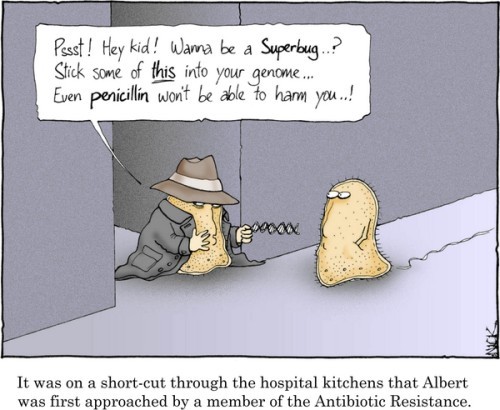
In her 2009 TED talk, “How Bacteria Talk,” Princeton molecular biologist Bonne Bassler speaks about her discovery of the languages of microbes, and how most types of microbes not only communicate among themselves, but also have a common language that allows them to communicate (and share genetic material) with other microbial species. One of the most interesting facts about the human microbiome is that 90% of the genetic material in and on a human being is from microbes. That is, the human body has about one trillion cells, but there are at least 10 trillion bacteria cells in or on the typical human body at any given time. So there are ten times more bacterial cells than human cells on a human being.
Something Bassler talks about is how microbes communicate and can share bits of DNA. This means they can easily share genetic materials, including those that provide resistance to antibiotics. Also of importance is the fact that when harmful bacteria proliferate due to lower populations of beneficial bacteria, the harmful bacteria “know” when they reach a critical mass necessary to enable a successful attack against their host organism. At this point, harmful bacteria that formerly may have been peacefully coexisting in balance with beneficial bacteria may take advantage of the situation to attack en masse.
Bassler’s TED talk helps explain how superbugs evolve and develop resistance so quickly, and how they know when their number are sufficient to launch a successful attack. Given what science now tells us about the nature of microbes and superbugs, it appears that olive leaf extract can play a significant role for protecting human health.
MORE ABOUT OLIVE LEAF AND ITS EXTRACT
A SHORT HISTORY OF OLEA EUROPEANA L. AND ITS THERAPEUTIC USE
Olive leaf extract derives from the leaves of the olive tree. The olive tree (Olea europeana L.) is a species in the ancient Oleaceae botanical family. This family also includes ash, jasmine, and lilac. Olive trees have been cultivated for thousands of years, especially in the Near East and the Mediterranean basin, including areas in Syria, Palestine, and Crete.
Fossil evidence found in Greece, Macedonia, and elsewhere indicates that the genus is native to the Mediterranean and Western Asia. Some evidence exists that it originated in tropical northern Africa and later was introduced to the Mediterranean via Egypt. References to olive trees and olives are plentiful in ancient Greek and Roman literature, and they figure prominently in the Bible, Hebrew Bible, and Quran.
Olive trees can live for thousands of years. Some currently living trees are more than 2,000 years old. A major reason that olive trees live so long are the natural chemicals in its leaves, bark, and fruit that protect them from parasites, insects, and fungi. While they are not 100% percent immune from attacks, they naturally repel invaders, and thereby protect themselves effectively enough to avoid catastrophic infections and infestations.
Cultivation of olive trees is estimated to have begun more than 7,000 years ago. Olives were propagated commercially in Crete as early as 3,000 BCE. Today, olives are grown on six continents and are one of the most extensively grown fruit crops in the world taking a total land area of almost 10 million hectares. 90% of cultivated olives are used for making olive oil. The other 10% become table olives.
Production is dominated by Mediterranean countries. As of 2011, Spain grows by far the most olives trees (and provides about 40% of the world’s olive oil) followed by Italy and Greece. Other important producers are Turkey, Morocco, Syria, Algeria, Tunisia, Egypt, Portugal, Argentina, Jordan, Australia, Lebanon, Israel, the United States, Chile, Croatia, and France.
In the New World, cultivation of olive trees began in Peru and Chile in the mid-1500s. Olives trees were established in San Diego, California in the 1700s by Spanish missionaries. Olive trees thrive along the Pacific coast of the Americas wherever a typically Mediterranean climate prevails. Thus, California olives are known and prized throughout the olive-consuming world.
OLEUROPEIN, ELENOLIC ACID, AND CALCIUM ELENOLATE
Olives in their natural state are highly bitter. In order to make them palatable, olives traditionally are fermented, cured using water or brine, or packed in salt. These processes leach out and breakdown the bitter glycoside known as oleuropein, as well as various phenolic compounds. Removing these natural substances is important for creating delicious olives. However, these are the very substances that protect the olive tree and its fruits from invasion by insects, microbes, and other pathogens. These substances also provide the antimicrobial and other therapeutic powers of the olive tree for human use.
During the Napoleonic era’s “Peninsular War” between Spain and France (1807–1814), Spanish doctors on the front lines developed a bitter drink made from the ground olive leaf. The bitter green drink was given to wounded soldiers suffering from high fevers. It was found that this drink could reduce a dangerously high fevers (104 degrees F and above) to far milder fevers of less than 101 degrees. This drink therefore significantly reduced recovery times for Spanish soldiers and allowed feverish soldiers to continue fighting. The French soon discovered the Spanish febrifuge and began using it for their soldiers.
After the war, Colonel Etiene Pallas, a French officer and medical doctor of the French Foreign Legion, who had served in Spain in 1811, began research into the therapeutic ingredients in the green olive leaf drink. He published his findings in a book about his experiences in the war (1827), an article in a medical journal (1828), and in his memoirs (1929) [2]. Dr. Pallas found that the leaves and young bark of the olive tree contain various therapeutic substances, foremost among them a bitter, yet colorless, non-odorous, and crystallizable substance he describes as “Vaqueline.” He ascribes most of the fever reducing characteristics of the olive leaf drink to this substance.
Following Dr. Pallas’s publication of information regarding the therapeutic powers of ground olive leaf, additional information was published in the medical literature into the 1850s describing teas and liquids made from olive leaf, particularly as a possible cure for malaria, which is caused by parasitic protozoans. Olive leaves were described as being boiled in water to make an olive leaf tea. In other instances, olive leaf tea was mixed with wine to make an olive leaf tincture (Tinctura Olea Foliorum).
Medical reports during the mid-1800s describe the improvement of malaria patients who drank olive leaf teas or consumed olive leaf tinctures. Other reports indicate that olive leaf teas were used in England for treating sick sailors and passengers returning from colonies in the tropics. Nevertheless, extracts of olive leaf were neither standardized for potency and effectiveness, nor were they used systematically for any diseases for which they could be useful, such as malaria.
Later in the 1800s, biochemists more carefully analyzed powdered olive leaf. It was determined that the active ingredient in olive leaf is a phenolic compound, which as given the name scientific name “Oleuropein.” Oleuropein is a bitter glucoside that is present in all parts of the olive plant, including its wood, roots, bark, fruit, and leaves, and which provides significant protection to the tree against insects and microbes.
Technically, the chemical formula for oleuropein (C25H32O13) classifies it as falling into the iridoid group of organic compounds, a group of secondary metabolites not directly involved in the growth, development, or reproduction of an organism, but often useful as medicines. While iridoids were first isolated in the 1830s, it was not until the 1960s that investigations were initiated to study the structure of the group.
BEYOND OLEUROPEIN
In the 20th century, it was determined that the primary substance in olive leaf for therapeutic purposes is elenolic acid, which is one of oleuropein’s hydrolysis products. Elenolic acid is what destroys or inhibits harmful microbes (along with another hydrolysis product known as aglycone) and offers benefits that differ from oleuropein, and in fact, can surpass it’s therapeutic effects by a wide margin.
The calcium salt of elenolic acid is known as calcium elenolate. In the late 1960s, researchers at The Upjohn Company isolated calcium elenolate, which provides unparalleled antimicrobial activity in vitro (i.e., in a test tube), but which is quickly (i.e., within minutes) bound by proteins in the bloodstream of living animals. It is this binding that inactivates the active ingredients and prevents the calcium elenolate from exerting lasting therapeutic effects in humans.
Upjohn continued its research in an attempt to synthesize and patent an antibiotic drug based on the calcium elenolate. However, they found no solution that could stop blood proteins from binding to calcium elenolate. The company ultimately abandoned the project because their researchers could not find a way to maintain in vivo the extreme potency demonstrated by calcium elenolate in vitro. That is, they could not surmount the challenge preventing calcium elenolate from binding with serum proteins in the blood. Nevertheless, the researchers at Upjohn performed much important work with olive leaf extract, including safety testing, which I will talk about further below.
EAST PARK’S SCIENTIFIC BREAKTHROUGH
Upjohn’s research determined that there are two forms of calcium elenolate in olive leaf extract. These two forms are biochemically termed stereo isomers, which means these are molecules with a certain “handedness.” The two forms exist as mirror images of one another with one being “left” (L) handed and other being “right” (R) handed in terms of their rotation and how they fit into the molecules of life.
In fact, many organic compounds (including most amino acids) found in nature have stereo isomers. Yet, while nature may produce equal amounts of both types (R and L) of isomers, nature uses only the left-handed amino acids in living proteins (DNA, RNA, etc.), for example. That is, the left handed forms are the only ones that interact with with molecules of life. This is the reason that L-form calcium elenolate can be deactivated in the body. The R-form, however, was discovered not to bind with blood proteins.
In addition, the handedness of a molecule can be determined by the way in which it reflects polarized light. L-forms (like L-arginine or L-carnitine molecules) reflect polarized light to the left. R-forms, such as R-calcium elenolate molecules, reflect the light to the right. Although Upjohn researchers determined that the right-reflecting, R-form of calcium elenolate (i.e., R-calcium elenolate) does not not bind to proteins in the bloodstream, they did not isolate a product that exhibited the pathogen-destroying capacities of R-calcium elenolate.
Research continued into the development of an olive leaf extract that exhibits all the potency of the extract in vitro, yet functions effectively in vivo for more than a few minutes. It was not until 1995 that scientists at East Park Research, Inc. discovered a process for extracting olive leaf extract that concentrates R-form molecules of calcium elenolate in a natural olive leaf extract product.
Due to the potency and effectiveness of the olive leaf extract product produced by East Park’s proprietary, patented extraction process, the therapeutic benefits of olive leaf extract are now available to consumers. In fact, largely due to the attention garnered by this powerful product, other companies have begun to create olive leaf extract formulas. Many of these other formulas provide high concentrations of oleuropein. While olive leaf extracts high in oleuropein exhibit some effectiveness, they do not offer the same benefits of calcium elenolate, much less its R-form.
It is therefore important when considering an olive leaf extract formula to use a formula proven to exhibit the highest effectiveness and potency. That formula is an olive leaf extract [link to hpdi product] that contains the R-form produced by the patented process developed by East Park Research, Inc. HPDI carries only this unique olive leaf extract formula.
Read more about HPDI’s Olive Leaf Extract, which is produced by East Park Research, Inc. using their patented method.
CONCLUSION
Living in a post-antibiotic age means we can no longer rely on “miracle” drugs when dealing with harmful microbes and superbugs. Olive leaf extract provides one of the most potent, natural means for protecting ourselves from even the most antibiotic-resistant bacteria, for example.
Olive leaf extract also affords us protection not only from a wide range of microbes, but also offers significant health benefits beyond its antimicrobial powers. These varied benefits include increasing energy levels, fighting chronic fatigue, reducing blood pressure, normalizing irregular heart beats, and many other benefits.
It is rare that a single plant extract can do so much for our health. That’s why olive leaf extract should be on your short list of natural supplements and be kept available at all times for when you may need it.
Notes
[1] Walker, Olive Leaf Extract, 41–42.[2] Walker, 52–53.
SOURCES & RESOURCES
BOOKS & PDF FILES
“Antimicrobial Attributes of Olive Leaf Extract.” Walker, Dr. Morton. Townsend Letter for Doctors and Patients, no. 156; 1996
Olive Leaf Extract. Walker, Dr. Morton. New York: Kensington Books, 1997
Olive Leaf Extract: Nature’s Secret for Vibrant Health and Long Life. Kent, Ohio: National Life Extension Research Institute, 1998
Olive Leaf Extract: Potent Antibacterial, Antiviral, and Antifungal Agent. Michele Hansen, ND & Andrew Verity, ND. Australia: Goldgolf Pty. Ltd., 2002 (.pdf)
STUDIES
Olive Leaf Extracts are a natural source of advanced glycation End Product Inhibitors (J Med Food. 2013 Sep;16(9):817-22)
Olive Leaf Extract as a Hypoglycemic Agent in Both Human Diabetic Subjects and in Rats (J Med Food. 2012 Jul;15(7):605-10)
Olive Leaf Extract Effective in Patients with Stage-1 Hypertension (Phytomedicine. 2011 Feb 15;18(4):251-8)
The olive leaf extract exhibits antiviral activity against viral haemorrhagic septicaemia rhabdovirus (VHSV) (Antiviral Res. 2005 Jun;66(2-3):129-36)
Anti-HIV activity of olive leaf extract (OLE) and modulation of host cell gene expression by HIV-1 infection and OLE treatment (Biochem Biophys Res Commun. 2003 Aug 8;307(4):1029-37)
Enhanced Resistance against Influenza Virus by Treatment with Dietary Supplement d-Lenolate in Neutropenic Mice Induced by Cyclophosphamide (Jrnl. Orthomolecular Med. 2001; 16(2): 102–114) [.pdf]
PRODUCTS
HPDI Olive Leaf Extract
(East Park Research process)
Organic Olive Oil
(Extra Virgin, Cold-Pressed, Hand-Harvested)


